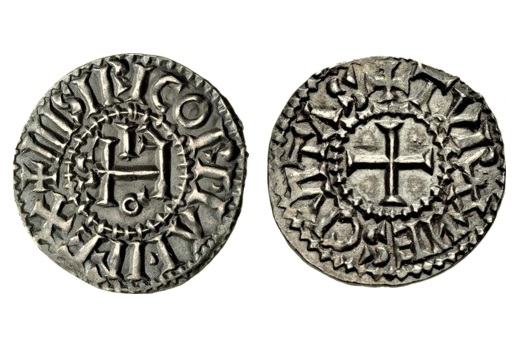
about ancient nomos
Ancient Nomos Art is a museum of galleries exhibiting ancient coins and ancient mint maps. The coin gallery displays the diverse art and history of hand-crafted ancient Greek, Roman, Byzantine, Persian and Medieval coinage. The ancient mints mapping gallery features Greek, Roman, Byzantine, Asia Minor and Medieval mint city regions and territories. Visitor's are welcome to explore, study and enjoy Ancient Nomos Art.

Medieval, France – 881 AD
Louis III 'le Jeune'
From Ancient Galleries

Obverse: Hludovicus monogram with rare "III" Louis le Jeune legend.
Reverse: Small cross pattée in center; quadrate O in Tours mint legend.
LEGEND
Obv: + IIISIRICORDIΛ DI REX, Hludovicus monogram with rare “III” Louis le Jeune as King legend. Rev: + TVROИES CIVITΛS, cross pattée; quadrate O in legend.
Louis III (the younger) was briefly King of West Francia, from 879 AD until his death August 5, 882 AD. He is the second son of Louis II “the Stammerer” and first wife, Ansgarde. Louis III and his younger brother Carloman II succeeded his father with co-reigns of West Francia. The Louis III reign was short, though marked by some memorable military successes. Louis III was born while his father was still just King of Aquitaine and his grandfather, Charles the Bald, was ruling West Francia. Some doubts were raised as to the legitimacy of the brothers, since their parents had married secretly in Ansgarde. The brother’s legitimacy allegations were later repudiated by Charles himself. When Charles died in 877 AD and then the elder Louis II also died within two years, one faction of nobles advocated electing the younger Louis III as sole king. However, apparently another faction of nobles favored each brother as co-rulers of the empire, with each governing separate spheres of territory. In September of 879 Louis III was crowned king at Ferrières and the brothers set out to divide their lands. During a conference at Amiens in March of 880, the brothers agreed to divide West Francia, with Louis III receiving the northern part, called Neustria. Although his reign was brief, Louis III did manage to achieve important and successful victory against Viking pirates at the famous Battle of Saucourt-en-Vimeu in 881 AD. The coinage of Louis III is also brief and scarce. Complicating the study of his coinage is the fact that most of the denier issues are almost indistinguishable from his father’s coinage, Louis II. This is where the city of Tours coin production workshops become the most important minting facility underKing Louis II & III. Their silver denier coins consist almost entirely of a single type, having an obverse monogram and reverse cross. There are very few coins of this type that distinguish the reigns of these two kings. However, after the death of Louis II, the minting authorities at Tours acknowledged Louis III’s explicit ascension, even though he and his brother Carloman shared co-rule of the empire. The above silver denier from Tours is a very rare example of coinage minted with a legend explicitly denoting Louis III as King and was likely minted sometime after his ascension in late 879 AD. The Louis III issues were minted at Tours and on a very small scale. An extensive Louis II & III Tours die study of coinage has been documented in the Catalogue des Monnaies Carolingiennes de Tours by Pierre Crinon. Here Crinon outlines eight monogram obverse die types for both Louis II and Louis III. The very rare denier above is consistent with only one obverse die, noted by Crinon as the inverted monogram type 6, with the S indicated on the left. The monogram 6 Latin legend reads; IIISIRICORDIΛ DI REX. The beginning “III” of the legend signifies Louis III as king. Louis III was the first to introduce the legend MISERICORDIA D-I REX to Carolingian coinage. The reverse legends, + TVROИES CIVITΛS, indicates the mint location as by the state of Tours, with a small cross pattée in the center. Louis III died suddenly on 5 August 882 at St. Denis, after presumably falling from his horse. He is remembered for his military aptitude and religious passion in the Old High German poem Ludwigslied, which commemorates Francia and Louis III’s victory over the Vikings. Carloman II became sole ruler of Francia upon Louis the younger’s early death.
DOCUMENTATION
Value: Denier. Metal: AR Silver. Weight: 1.76 grams. Mint: Turones (Tours), West Francia. Date: Struck circa 881 AD.
Attribution: BNC, Cabinet des Médailles, 459a, F(8788) = RN 1915 p. 226 et pl. VI = Trésor de Savigné and BNC 460, C (2481a), collection of J. Rousseau = Prou 459 = Garie 15 pl. XXXVIII = RN 1915, p. 226; Depeyrot 1041; M&G 1256; MEC 1, 967 variety. (legend without “III”). Photo courtesy CNG.
Legend, Documentation and Attribution
